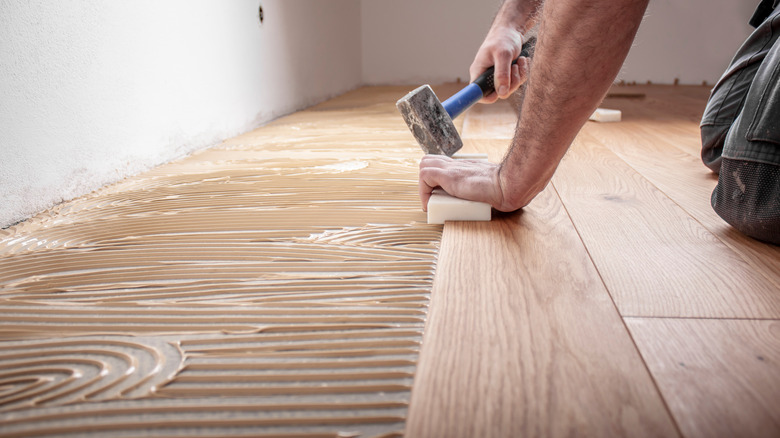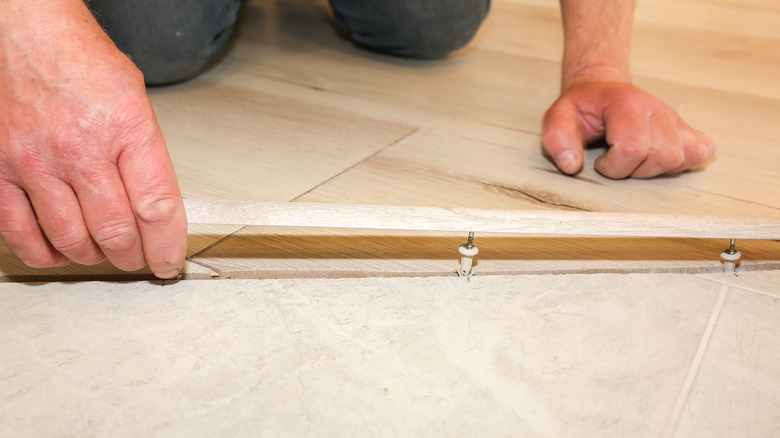Can You Install Wood Flooring Over Ceramic Tile?
The type of flooring you decide to install in your home goes a long way in setting the mood and aesthetic of your space. That is why planning your interior decoration is key. Ceramic tiles are a popular choice for many homeowners looking to have floors that are not only durable but easy to take care of. Messes and spills are promptly wiped up, and the tiles won't stain. Ceramic flooring is also versatile and can mesh well with every room of the house, from living rooms to kitchens and to your bathrooms, too. However, sometimes, you can get tired of having ceramic tiles and may want to switch things up by installing wood flooring. If you're in this boat, then you probably want to know if it's even possible to lay the wood over the tiles. The answer is yes ... technically.
Changing your ceramic tiles to wood floors might seem like an unnecessary expense to some, but the cost of removing the tiles as opposed to installing the wood on top is quite high. Wood provides a cozy setting that other types of flooring just can't live up to. If you already have ceramic tiles that you want to overlay with wood, you will have to consider the type of wood you want and the effort associated with it. Successfully installing wood flooring over ceramics is doable if you're using engineered wood or a transition strip if you're going for solid wood.
Prep the ceramic tiles before gluing down the wood flooring
A lot of work is needed to prep ceramic tiles to be overlayed with wood flooring, especially depending on the type of wood you intend to use. If you want solid wood, you can't just install it over the tiles. You should first install a plywood subfloor that's at least ⅝ inch thick before nailing the solid hardwood flooring on it. This will cause your floors to be too raised and will impact the integrity of the surrounding rooms and household appliances as well. Most experts advise you to go with engineered wood instead.
Home Improvement expert Danny Lipford via Today's Homeowner recommends using engineered wood flooring or laminate flooring. Your first step should be prepping the ceramic floor by etching it before laying the hardwood over it. "Check to be sure the existing floor is flat first and fill in any low spots with leveling compound," he stated. "If the wood floor is being glued to a slick tile surface, rough the tiles up a bit by sanding them to allow the adhesive to adhere better."
Then, it's time for priming. A mechanical bond primer should be used to enhance adhesion. After, a leveling compound is used to even out the surface before applying a strong polymer adhesive and installing your new floors. If you're not the hands-on type, you'd definitely want to get a professional to do this for you.
Things to consider before overlaying ceramic tiles with hardwood flooring
Upgrading your ceramic tiles to wood floors is no small feat because it will affect how your room borders with the other rooms and the appliances and electric outlets. Although using engineered wood flooring over solid wood won't give you the same thickness, stacking it on top of the tiles still makes a difference in the overall floor height. You may need to shorten the length of your doors so that they can swing above the new floor. Also, if you only added wood flooring to one room, any bordering room will probably need a transition strip to address the height difference.
Although overlaying ceramic tiles with wood flooring comes with cost benefits and reduced labor, you can also encounter several problems. The ceramic tiles under the wood stand the risk of lifting. Additionally, the adhesive holding the wood to the tiles can also weaken. This usually happens if the tiles aren't properly sanded and cleaned of debris during the preparation stage. It could also occur if you use the wrong glue. Finally, there is the issue of having the floors become unleveled, which could end up damaging the wood.


